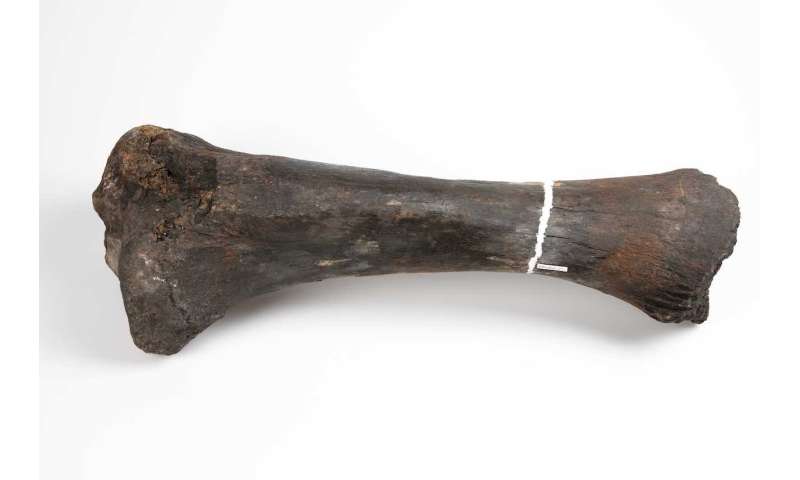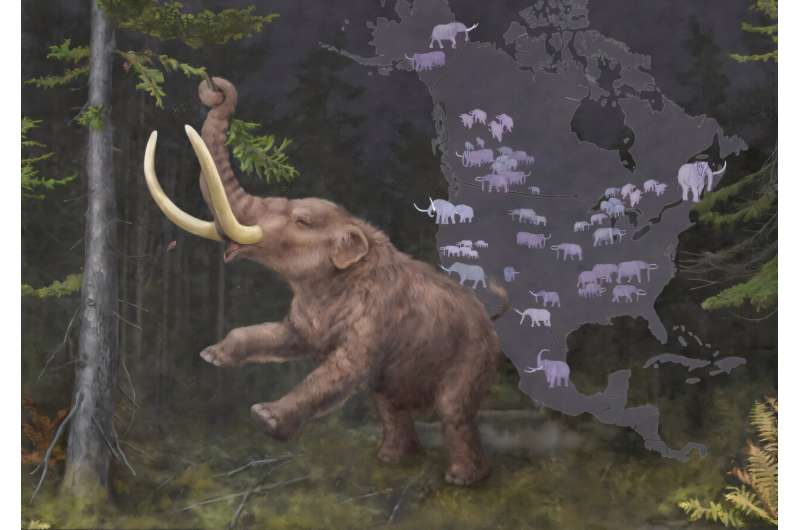An ancient DNA analysis of the remains of several mastodons, including those which roamed along the Pacific and Atlantic coasts of North America, has revealed the Ice Age giants migrated vast distances in response to shifting climates and were far more genetically diverse than previously known.
In the study published in the journal Science Advances, researchers from McMaster University and Harvard provide new evidence which significantly revises and reshapes our understanding of the species’ deeply complex evolutionary history.
Well-preserved fossilized specimens of teeth, tusks and bone—dating back hundreds of thousands of years—coupled with new scientific techniques, have allowed researchers to reconstruct genomes from ancient, tiny, degraded DNA fragments.
They reconstructed the mitochondrial genomes from several mastodon specimens: five from Nova Scotia and the eastern seaboard, one of which may date to approximately 500,000 years ago, and for the first time, a unique specimen of a Pacific mastodon from Tualatin, Oregon, in addition to a partial mitochondrial genome from Northern Ontario.
Mastodons were initially split into numerous separate species but later consolidated back into a single one—Mammut americanum. More recently, this classification has been revised to potentially include at least two distinct species: the American and the Pacific mastodon (M. pacificus), although a debate over the split has persisted.

The genetic analyses confirm the Pacific mastodons belong to a very old, well-established and separate genetic branch, with a range that extends much farther than previously believed—reaching deep into the Pacific Northwest, possibly south to Mexico, and as far north as Alberta.
Interestingly, Alberta appears to have been a “hot spot,” say scientists, where Pacific and American mastodons congregated, expanded northward and may have interbred.
The East Coast and Northern Ontario specimens revealed two new and distinct genetic groups, known as clades, of mastodons living in the same region but at different times.
The eastern species were surprisingly diverse, arriving in distinct waves of migration at least three times—a pattern driven by repeated cycles of climate warming, leading to glacial melting and the opening of new territory for northward expansion. When the climate cooled and glaciers expanded, mastodons were driven south or went locally extinct.
-

Middle River Mastodon femur, estimated to be 91,000 years old, found in a gypsum sinkhole in Nova Scotia. Credit: Nova Scotia Museum
-

Little Narrows Mastodon tibia, estimated to be 358,000 years old, is likely the oldest mastodon with available genetic data. Credit: Nova Scotia Museem
“The data shifts our view of the region today known as Alberta and the north more generally, from a marginal roaming ground to a repeatedly occupied migratory corridor and significant landscape for mastodons with possible interbreeding,” says senior author and evolutionary geneticist Hendrik Poinar, director of the McMaster Ancient DNA Center and the Michael G. DeGroote Chair in Genetic Anthropology.
Researchers also pinpointed a mysterious and genetically distinct Mexican mastodon lineage, which they believe could be a deeper branch of the western species M. pacificus or possibly an entirely new, third mastodon species.
The mastodon was among the largest living land animals on Earth during the Ice Age, roaming from Beringia (present-day Alaska and the Yukon) east to Nova Scotia and south to Central Mexico. They were primarily browsers, living in swampy settings, eating shrubs and low-hanging tree branches, and occupied a very different habitat from their distant cousins, the iconic Ice Age woolly mammoths, which roamed on open grasslands and tundra.

“This study represents several firsts, which includes our work on the Pacific mastodon. It also poses many new questions. For example, how did these distant species of mastodon interact in Alberta? Did they compete for resources, or did they interbreed as our lab has previously shown for mammoths?” says lead author Emil Karpinski, a former graduate student at the McMaster Ancient DNA Center, now a research fellow in the Department of Genetics at the Harvard Medical School.
These new findings, combined with those reported in a 2020 study conducted by the same team, create a much more complete picture of how mastodons moved and diversified across North America, helping conservationists today prepare for an ever-warming arctic and northern migrating species, say researchers.
More information:
Emil Karpinski et al, Repeated climate-driven dispersal and speciation in peripheral populations of Pleistocene mastodons, Science Advances (2025). DOI: 10.1126/sciadv.adw2240. www.science.org/doi/10.1126/sciadv.adw2240
Provided by
McMaster University
Citation:
Ancient DNA reveals deeply complex Mastodon family and repeated migrations driven by climate change (2025, September 12)
retrieved 13 September 2025
from https://phys.org/news/2025-09-ancient-dna-reveals-deeply-complex.html
This document is subject to copyright. Apart from any fair dealing for the purpose of private study or research, no
part may be reproduced without the written permission. The content is provided for information purposes only.

